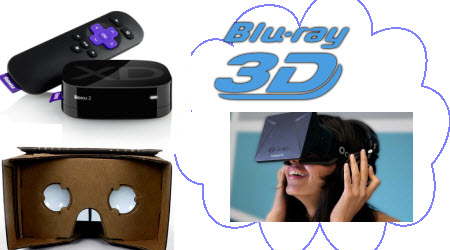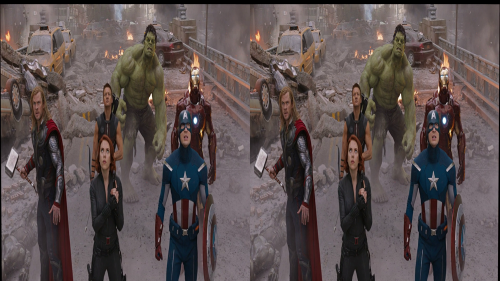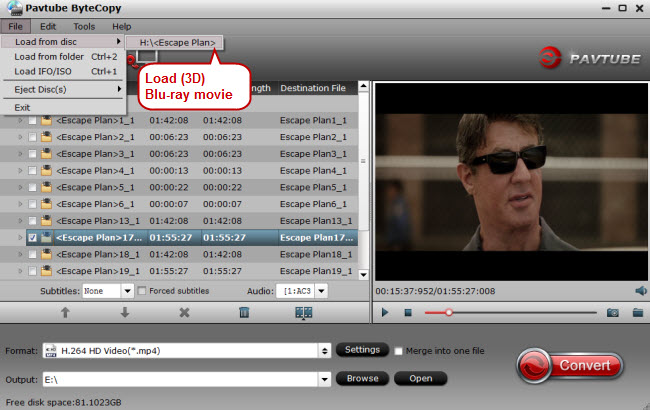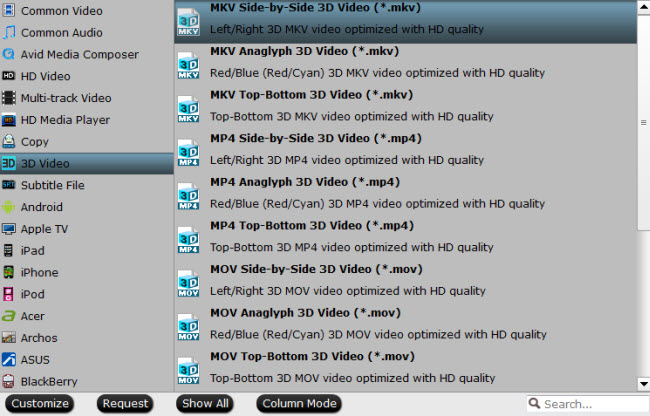One of the benefits to Google Cardboard, Oculus Rift, and similar phone-based headsets is stereoscopic 3D. As a big supporter of stereoscopic 3D, what I want to do is to rip 3D Blu-rays I own to side-by-side 3D files that I can play from Plex server through my Roku onto my 3D TV. Besides I decided to play around with converted 3D files on Cardboard/Oculus Rift. I am just wondering what would be the best way to go about it?

In fact, I would say I’m somewhat of a Blu Ray ripping novice. I usually use the disk. I’ve been experimenting with a pile of 3D Blu-ray ripping tools and finally decide one. Now I’m sharing the way to convert and play 3D Blu-ray for Roku, Google Cardboard, or Oculus Rift with ease.
Conversion requires several steps and programs. Basically, it’s not for the faint of heart or those with older PCs (unless you want to wait a long time for the various conversion processes.) You’ll need the following programs:
A program to strip the idiotic AACS encryption from the Blu-ray. Here I found Pavtube ByteCopy (Read review) which aims to solve this problem by giving us the ability to rip our purchased physical 3D Blu-ray discs to 3D SBS video for watching on Google Cardboard, Oculus Rift, 3D TV via Roku as well as other 3D players. In addition, it’s professional in ripping and converting Blu-ray/DVD discs, Blu-ray/DVD ISO image, Blu-ray/DVD copies and more to a decent format you want. Also, it will help you backup your 2D/3D Blu-ray disk and save the time looking for them from the cardboard with ease. If you are working on Mac OS X, please get the mac version.
All tools you need:
- Virtual CloneDrive from Slysoft (freeware)
- ByteCopy (Not free but useful and stays updated)
- VLC media player (free, open source) to test the playback although Windows Media Player might work
Finally, I’ll just tackle this one right here. If you do any of this with a 3D Blu-ray that you don’t legally own and/or you provide the resulting file to others, especially over BitTorrent or whatever, you’re part of the problem!
Step 1 – Mount the ISO as a Separate Drive
If you have backed up 3D Blu-ray in ISO files, just instal Virtual CloneDrive, right-click on the ISO and select “Mount Virtual CloneDrive drive_letter”. That ISO will then be available as whatever drive letter was listed. If you saved the Blu-ray image to a directory with the same file structure, skip step 1.
Step 2 – Remove the AACS Encryption and Convert to Side-By-Side 3D
First, a bit of information. 3D Blu-ray in general acts on the principle of alternating frames for each eye, although there are several methods that can be used. For example, odd-numbered frames might be for the left eye whereas even-numbered frames are for the right eye. The TV will display those based on whatever technology is being used, whether it’s active, passive/polarized, or even red/blue anaglyph. Side-by-side 3D means taking each frame, compressing them horizontally, and fitting them in a single frame. This results in the separate left-eye/right-eye 1920×1080 frames becoming two individual 960×1080 images inside the same frame. When you look at these, you can actually see the 3D composite if you use the “relaxed eyes” method.

When playing back side-by-side 3D on your 3DTV, you have to tell your TV to switch to side-by-side 3D mode. It will then recreate the proper 3D image from each half of the frame. The result will be at half the horizontal resolution as the Blu-ray, but it will still look incredibly good. Here is the step-by-step guide on ripping, converting for Roku, Google Cardboard, or Oculus Rift
a: Load Blu-ray movies
Insert your Blu-ray disc into your BD drive, run ByteCopy and click “BD/DVD disc” icon to load 3D Blu-ray movies.

b: Choose output format
Click the format bar to follow “3D Videos” and choose the 3D Side-by-Side MP4 format which can fit your 3D devices perfectly.

c: Start 3D Blu-ray ripping
Click the convert button under the preview window, and the Blu-ray ripper will start the conversion from Blu-ray movies to 3D SBS video.
If you want to play this through a Roku or similar streaming box, then I recommend using the settings and explanations at rokoding.com. Their setting suggestions have worked incredibly well for me. If this is your final goal, then you don’t need to follow any more steps in this guide. Just follow the directions at rokoding.com, then copy the resulting file over to wherever your Roku can see it (I highly recommend setting up a Plex server) and it should play without a problem. You’re done, although you’ll need to manually switch your TV to side-by-side 3D during playback.
If you want to play this on a VR headset like Google Cardboard or Oculus Rift, use the steps from rokoding.com, and then go back to the Video tab to adjust the width and height of the final file, as described in the next step. Don’t click Start just yet!
Step 4b: Calculating the Final Resolution for VR Playback
Follow me on this one…
As you can see from the image above, the side-by-side image is compressed horizontally to fit both 3D images into one frame. The aspect ratio (AR) of a standard Blu-ray frame is 1.77:1, meaning that the frame is 1.77 times the height for a resolution of 1920 x 1080. The side-by-side conversion results in the two 3D images getting compressed, so you now have two images of 960 x 1080 in the same frame. In order to show each half image in its original 1.77:1 aspect ratio, we need to cut the vertical resolution in half from 1080 to 540. This will result in two 1.77:1 frames for a total AR of 3.54:1 as shown below.

Now that we know that the final output width has to be 3.54 times the height, we can start working with some numbers to fit your VR device.
A video file with a resolution of something smaller like 960 x 270 will still look really good on your VR headset but can have a significantly smaller file size than its 1280 x 360 counterpart. Just copy the converted 3D SBS file to your VR device and play the file! You’re done! (You might need to install a third party file manager in order to locate and play back the video file on your device.)
About VR Playback
There are a few things about VR playback that you need to be aware of. The biggest is that you likely will not be able to see the entire screen, but perhaps 70% of it. The extreme sides will be out of your field of view. This is due to the depth of field view and the focal point of the headset. The immersion of 3D or VR in general is slightly broken if you can see edges when running a VR application or game, so edges are placed out of view. We’re watching a movie with a static location, so we don’t need to worry about 360 degree immersion. Unfortunately, the only way to fix this when it comes to 3D movies is to reduce each eye’s half of the frame relative to their own virtual center as shown in the example below.

Doing this requires extracting the left and right eye frames separately then using a video editor to produce the final results. That also brings in a lot of questions about how to get the audio synced up for the final file and so forth. This process is by no means impossible, but it does add a lot of work – unless whoever maintains BDtoAVCHD implements a method to shrink each of the various frames down during the conversion.
The other issue is that the 3D depth is not as pronounced as it would be if you were watching the movie in a theater or on your 3D TV. You won’t feel as much of a sense of distance going back into your VR headset, but you’ll definitely see a difference for objects that are closer to the screen. You can adjust your phone left or right in your Cardboard holder to help to maximize the 3D depth as well as focus the viewing area as closely to the center of the screen as possible.
Keep in mind that this whole process isn’t meant to replace a 3D TV or going to a theater anyway. If you expected the same kind of immersion, you need to lower your expectations. It’s still a fun way of using your VR headset to watch your favorite 3D movies!
So, go ahead and have some fun with this! Let me know how successful you’ve been, but please note that due to spambots the comments are closed after a certain length of time.
Enjoy — Watch 3D Blu-ray on Google Cardboard, or Oculus Rift and 3D TV via Roku freely. but don’t be part of the problem! If you keep pirating 3D Blu-rays, what incentive does Hollywood have to release them in the future?
Source from here.









Leave a Reply
You must be logged in to post a comment.